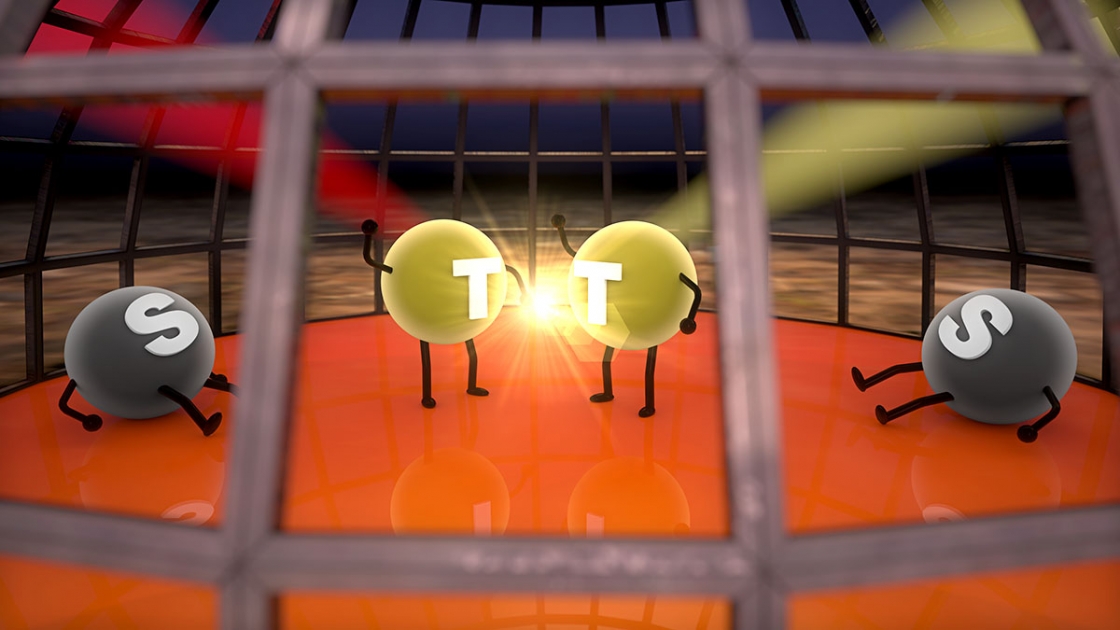When it comes to photoluminescence, the rules for most materials are simple: shine a photon on the material, and one photon comes out. Other materials take some coaxing—shine two photons in and get a shorter wavelength photon out in a process called upconversion photoluminescence, or UCPL.
Many organic materials require a chemical sensitizer to get that upconversion photoluminescence—except for rubrene. This orange-tinted organic crystal can perform this upconversion photoluminescence process without an added sensitizer.
“The mystery was: why does this work for pure rubrene?” JILA Fellow Mathias Weber asked.
To answer this question, the Weber Group needed to learn the rules and the players for UCPL within the crystal. In their recently published study in the Journal of Physical Chemistry Letters, they found that this process plays out like “photon Thunderdome,” which could help scientists and engineers create new light sources and new technology that can harness the non-visible spectrum of light.
Photon Thunderdome
From earlier research, it was clear that UCPL is caused by a process called triplet-triplet annihilation, in which two particles with parallel spins combine, but at first it was not clear how the light was initially absorbed. Regular rubrene molecules don’t absorb near-infrared light.
Another weird behavior found in earlier research has to do with the number of incoming photons required to get one photon out. For simple photoluminescence, one needs one photon to go for one photon to go out. For triplet-triplet annihilation, two photons need to go in for one to come out. In rubrene, UCPL takes four photons.
Weber grinned as he summarized this as a molecular version of Thunderdome: “Two photons enter, one photon leaves. In rubrene, the rule of Thunderdome is four photons enter, one photon leaves.”
To get to the bottom of how UCPL in rubrene works, the Weber Group needed to learn exactly which wavelength of light caused this reaction, and what inside the crystal started the process. They scanned the wavelength of invisible near-infrared light they shone on a rubrene crystal, tuning their laser until they saw a flash of yellow light—a sign of UCPL. These near-infrared wavelengths told them what exactly started the UCPL process—positively-charged ions (called cations) and negatively-charged ions (called anions), probably on the crystal’s surface.
Two photons kick one cation and one anion into excited states. The cation and anion interact, combining their charges, and creating a rubrene molecule in its singlet ground state, and one in a triplet state. Another two photons achieve the same outcome with another pair of ions. The two triplets then combine, producing an excited singlet. That excited singlet fluoresces, and scientists see a blip of yellow light.
Now that the Weber Group knew that they needed a cation and an anion to get the process going, they could model it. In modeling the process, they were able to explain its other peculiar quality.
“The process needs four photons, so the output varies with the fourth power of the intensity of the incoming light. If you double the intensity of the incoming light, your output is sixteen times higher than before, and our model can account for that,” Weber said.
The ability to sustain UCPL is an interesting material property, because the photons released in upconverted photoluminescence have a higher energy than the photons that went in, Weber pointed out. In photovoltaics, upconversion can be used to convert low-energy photons that cannot directly generate electricity into higher-energy photons that can. Although pure rubrene doesn’t do this very efficiently, understanding this process could lead to better solar cells.
UCPL could also be used in relatively simple sensors in future quantum technology. For example, the process could be used to test the quality of novel light sources that produce “entangled light”, such as photon pairs rather than one photon at a time.
This study was published on August 10, 2020 in the Journal of Physical Chemistry Letters and was supported by the National Science Foundation’s Physics Frontier Center grant and the American Chemical Society Petroleum Research Fund.
Written by Rebecca Jacobson



 The Physics Frontiers Centers (PFC) program supports university-based centers and institutes where the collective efforts of a larger group of individuals can enable transformational advances in the most promising research areas. The program is designed to foster major breakthroughs at the intellectual frontiers of physics by providing needed resources such as combinations of talents, skills, disciplines, and/or specialized infrastructure, not usually available to individual investigators or small groups, in an environment in which the collective efforts of the larger group can be shown to be seminal to promoting significant progress in the science and the education of students. PFCs also include creative, substantive activities aimed at enhancing education, broadening participation of traditionally underrepresented groups, and outreach to the scientific community and general public.
The Physics Frontiers Centers (PFC) program supports university-based centers and institutes where the collective efforts of a larger group of individuals can enable transformational advances in the most promising research areas. The program is designed to foster major breakthroughs at the intellectual frontiers of physics by providing needed resources such as combinations of talents, skills, disciplines, and/or specialized infrastructure, not usually available to individual investigators or small groups, in an environment in which the collective efforts of the larger group can be shown to be seminal to promoting significant progress in the science and the education of students. PFCs also include creative, substantive activities aimed at enhancing education, broadening participation of traditionally underrepresented groups, and outreach to the scientific community and general public.